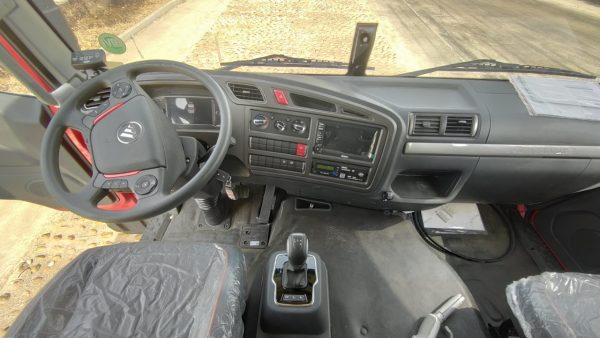Introduction

Truck-mounted cranes have become essential equipment for a wide range of industries that require heavy lifting and transportation tasks. These versatile machines combine the mobility of a truck with the lifting capability of a crane, making them ideal for various applications in construction, logistics, mining, and many other fields. In this comprehensive guide, we will explore the features, benefits, and applications of truck-mounted cranes for heavy-duty tasks.
1. Overview of Truck-Mounted Cranes
Truck-mounted cranes, also known as boom trucks or mobile cranes, are designed to provide flexibility and efficiency in lifting and moving heavy loads. These cranes are mounted on a truck chassis, allowing them to be easily transported to different job sites. The crane boom can be hydraulically extended and retracted, providing a wide range of reach and lifting capacities.
2. Types of Truck-Mounted Cranes
There are several types of truck-mounted cranes available, each with specific features and capabilities to suit different applications. The most common types include:
- Telescopic Boom Cranes: These cranes have a telescoping boom that can extend to various lengths, providing increased reach and lifting capacity.
- Knuckle Boom Cranes: Also known as articulated cranes, these cranes have a hinged boom that can be folded and unfolded, allowing for greater flexibility in maneuvering and positioning loads.
- Lattice Boom Cranes: These cranes feature a lattice boom made of interconnected steel sections, offering high lifting capacities and stability for heavy-duty tasks.
3. Features and Components of Truck-Mounted Cranes
Truck-mounted cranes are equipped with a range of features and components to ensure safe and efficient operation. Some key components include:
- Boom: The main lifting arm of the crane, which can be extended and retracted to reach different heights and distances.
- Counterweights: Used to stabilize the crane and prevent tipping when lifting heavy loads.
- Hydraulic System: Provides power to extend and retract the boom, as well as control other crane functions.
- Outriggers: Extendable legs that provide additional stability and support when lifting heavy loads.
- Controls: Operators use a control panel or remote control to operate the crane, adjusting boom extension, rotation, and lifting functions.
4. Benefits of Truck-Mounted Cranes
Truck-mounted cranes offer a range of benefits that make them a preferred choice for heavy-duty tasks:
- Mobility: The ability to transport the crane to different job sites quickly and easily saves time and labor costs.
- Versatility: Truck-mounted cranes can be used for a variety of lifting tasks, from construction projects to loading and unloading cargo.
- Efficiency: These cranes are designed for fast setup and operation, increasing productivity and reducing downtime.
- Safety: With advanced safety features such as load monitoring systems and overload protection, truck-mounted cranes help prevent accidents and injuries on the job site.
- Cost-Effective: Investing in a truck-mounted crane eliminates the need for renting or outsourcing lifting equipment, saving money in the long run.
5. Applications of Truck-Mounted Cranes
Truck-mounted cranes are used in a wide range of industries and applications for heavy lifting tasks. Some common applications include:
- Construction: Truck-mounted cranes are essential for lifting and placing heavy materials such as steel beams, concrete panels, and equipment on construction sites.
- Logistics: These cranes are used in warehouses, ports, and distribution centers for loading and unloading cargo containers and heavy machinery.
- Utilities: Utility companies use truck-mounted cranes for tasks such as installing power lines, repairing infrastructure, and maintaining equipment.
- Mining: Truck-mounted cranes are used in mining operations for lifting and moving heavy materials, machinery, and vehicles in challenging terrain.
- Forestry: In the forestry industry, these cranes are used for loading and transporting logs, as well as equipment for logging and processing wood.
6. Safety Considerations for Operating Truck-Mounted Cranes
Safety is paramount when operating truck-mounted cranes for heavy-duty tasks. Operators and site personnel must follow strict safety protocols to prevent accidents and injuries. Some important safety considerations include:
- Proper Training: Operators should receive comprehensive training on crane operation, safety procedures, and equipment maintenance.
- Going Here and Maintenance: Regular inspections and maintenance of the crane and its components are essential to ensure safe and reliable operation.
- Load Capacity: Operators must adhere to the crane's rated load capacity and never exceed the maximum weight limit to prevent overloading.
- Ground Conditions: Ensuring stable ground conditions and proper setup of outriggers are crucial for crane stability and safety during lifting operations.
- Communication: Clear communication between the crane operator and ground personnel is essential to coordinate lifting tasks safely and efficiently.
7. Future Trends in Truck-Mounted Crane Technology
Advancements in technology are driving innovation in the design and capabilities of truck-mounted cranes. Some emerging trends in crane technology include:
- Remote Monitoring: IoT-enabled sensors and telematics systems allow operators to monitor crane performance, maintenance needs, and safety alerts in real-time.
- Automation: Automated features such as self-leveling systems, anti-collision sensors, and automatic load detection are enhancing crane operation efficiency and safety.
- Electric and Hybrid Models: The shift towards electric and hybrid power sources is reducing emissions and fuel costs, making truck-mounted cranes more environmentally friendly.
- Improved Ergonomics: Crane cabs are being redesigned with ergonomic features and enhanced visibility to improve operator comfort and safety during long hours of operation.
8. Conclusion
Truck-mounted cranes are indispensable equipment for industries that require heavy lifting and transportation tasks. Their versatility, mobility, and efficiency make them a valuable asset for a wide range of applications, from construction and logistics to mining and utilities. By understanding the features, benefits, and safety considerations of truck-mounted cranes, operators can enhance productivity and safety on the job site while maximizing the crane's capabilities for heavy-duty tasks. As technology continues to evolve, the future of truck-mounted cranes promises even greater advancements in performance, safety, and sustainability.
